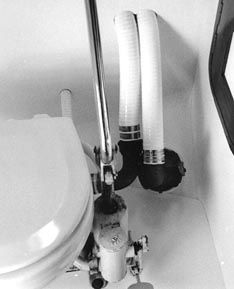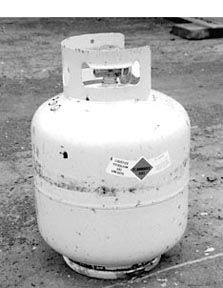When the Volvo Ocean Race fleet arrives in port after every leg, shore crews swarm over the boats at the same time the sailing crew climbs off. Within a few hours, every piece of removable gear inside, from the galley pot to the emergency flares, is off each boat. Within a day, most of the rigs are out of the boats, with every piece of standing rigging and running rigging removed for examination or replacement. Literally inch by inch, every piece of each boat gets examined in detail by the shore crew. With as little as two weeks between a finish and the next start, the pace is fast, but thorough.

Theirs is no haphazard program of maintenance. Each shore manager has created a multi-page checklist of procedures and job assignments to make sure that nothing is overlooked. You may not be racing around the world, or even cruising across oceans, but the same methodical, organized maintenance program that keeps a Volvo 60 racing can be adapted to any boat, large or small. Unfortunately, most of us don’t have shore crews to do the work, nor do we have the budgets to pay someone else to do most jobs. Like it or not, we are the shore crew as well as the sailing crew.
Rule number one of any maintenance program is simple: never trust your memory. A written maintenance log is essential. It can be as simple as a hand-written notebook, or as sophisticated as a computer spreadsheet. There’s even proprietary computer software for creating maintenance logs. Whether sophisticated or simple, the basic requirements of any maintenance log are the same:
1. Divide jobs into categories.
2. Define the task.
3. Determine the service interval.
4. Note specialized tools or materials required.
5. Inventory consumable materials.
6. Record the date the job is actually done.
In addition to the primary log, we keep a small notebook on the chart table at all times for writing down jobs that may not appear in the normal maintenance schedule. Examples of these jobs would be a spreader end whose chafe gear comes loose during a passage, or a sticky spinnaker pole end fitting discovered during a jibe.
No matter how good you are at routine maintenance, not every job will get done in a timely fashion, and you’ll always come into port with a significant worklist after a passage. If you’ve written things down under way, you have a huge head start on the job when you get into port.
Divide Jobs into Categories
Your maintenance log should be organized into rational categories. Obvious headings would be engine and drive train, hull exterior cosmetics, electrical system, plumbing, deck hardware, safety equipment, rig, and sails. Less obvious major subdivisions would be jobs that can be done in the water, and those that can only be done with the boat hauled.
Define the Task
The degree of detail required here will vary. “Change engine oil” may be enough detail to tell you to pump out the old oil, put in the new oil, change the oil filter, wipe down the outside of the engine, and replace the oil-absorbing mats in the drip pan. You may need more detail, however, if your oil-changing routine includes less-obvious tasks like tightening oil pan bolts.
Determine the Service Interval
Some service intervals are defined by the equipment manufacturer, such as yearly liferaft inspection. Others can only be determined through experience.
Changing engine oil every 100 hours of operation may seem to be a no-brainer. But if you’re a seasonal sailor who puts few hours on the engine every year, you may need to change oil based on the passage of time, rather than the hours of use. Deciding how often you need to tear down deck hardware or service the sheaves in a boom or mast is less clear-cut, and may be determined by the amount of usage, the passage of time, or some combination of both.
Schedules based solely on time intervals will need to be adjusted if the type of sailing you do changes. A once-a-year tear-down of deck and mast winches may be perfectly adequate for a boat in year-round service if that boat is used for relatively easy sailing, and if it gets a thorough freshwater washdown every time it returns to the dock. The service interval for those same winches may be cut in half if the boat makes ocean passages and rarely has access to large amounts of fresh water for cleaning.
The service interval may also change as a result of unusual circumstances. For example, by the time Calypso reached Israel last year, every piece of deck hardware was full of grit from Red Sea sandstorms. All winches needed a complete tear-down, solvent wash, and re-greasing, even though they had been totally overhauled less than eight months before.
Service intervals are for guidance purposes only. They should represent the maximum time intervals for doing a specific job.

As mentioned previously, a separate haulout maintenance list is critical, as you don’t want to remember that you need to grease the feathering prop the day after you go back into the water. The haulout list is particularly critical for a cruising boat, which may be out of the water under severe time pressure. The last thing you want to do is create a worklist after you’re hauled, with the yard manager breathing down your neck to get the boat out of the yard.
Having a haulout worklist—complete with a rational estimate of the hours required for each job—will help you make a reasonable estimate of just how long you really need to be out of the water. You can’t cram five days of maintenance into a three-day haulout.
Determining how often to do a job is one of the most difficult decisions on a cruising boat. You always seem to have to prioritize maintenance jobs, as there never seem to be enough hours in the day to get everything done. Just remember that you can’t defer any job indefinitely. Putting off doing the varnish in order to service the engine may make sense before starting a passage, but deferred maintenance will catch up with you, sometimes in a big way.Being systematic in your maintenance program will greatly reduce the number of deferred jobs that come back later to bite you in the rear.
We have found that putting a few hours of work into the boat on a daily basis—even if we’ve just arrived in port and would rather rest or sightsee—helps us stay on top of jobs far better than trying to tackle everything in a series of long days just before starting a passage.
Specialized Tools and Materials
Few things are more frustrating than getting ready to do a job, only to find that the wrench you need to access the drain plug on your transmission, or to take apart the toilet, is not in your tool box. This could be a minor inconvenience if it just requires a trip to the local Ace Hardware store, but it could be a disaster if you’re anchored in Eritrea, or even in a remote spot in the Bahamas.
When you’re creating your maintenance log, examine each job carefully to make sure no unusual tool is needed. For example, we have spin-on oil filters and secondary fuel filters on our engine, but the same strap wrench cannot be used for both filters. The oil filter takes a large wrench, the fuel filter a smaller one.
Before we switched to a Speedseal cover on our engine’s raw water pump, we had to have a special stubby screwdriver to undo the screws on the original impeller cover. Because of access issues, I’ve often had to modify standard tools to fit in tight places. If a special tool is needed, make a note of it.
The same differentiation may exist for materials as well. The low-viscosity white grease you use for winch bearings would be a poor choice for lubricating the pump shaft on the toilet, where stiffer grease will last longer and is more effective at stopping leaks.
Inventory Consumables
This includes everything from keeping track of the number of oil filters onboard to knowing how much sandpaper and varnish you have.
Obviously, you can go overboard on this. I certainly have no idea how many No. 10 stainless steel flat washers we carry, but I can keep an eye on the supply every time I go into the fastening locker, and make a note in my “to buy” book when the stock starts to get low.
At the same time, I know exactly how many oil filters, fuel filters, and gallons of engine oil are aboard.
If you have a preference for a specific product (we’re almost superstitious in some of our preferences, such as Simple Green cleaner, Collinite Fleetwax, and Goldspar varnish) you’ll need to keep a closer eye on your inventory than if you’re less picky. If you live right around the corner from the local chandlery, you can be a lot less concerned about your onboard inventory of consumables than if you’re taking off around the world.
It does no good to know that you have something in inventory if you don’t know where it is. This is more important for rarely-used items that may be stored in out-of-the-way places. If it’s something that may be needed in an emergency, make sure you not only know where it is, but that you can get to it in a hurry.
In theory, you shouldn’t need emergency access to maintenance items. But if you have to tear the boat apart to get to the grease for the primary winches, they won’t get serviced very often. At the same time, you may well store topside-care items such as wax, polishes, and acid cleaners—which may only be used once a year—in less-accessible locations.
In a nutshell, store things rationally, and record their locations.
Log the Job
When exactly was it that you pickled the watermaker membrane? Did you change the transmission fluid at the last engine oil change, or the one before?You can’t trust your memory on these things. Write it down.
You should also note any out-of-the-ordinary thing you noticed while doing routine maintenance, even if it’s something that doesn’t need immediate attention. Acrylic hatches that are showing the first signs of crazing may not call for immediate replacement, but you know you’re going to have deal with them eventually.
Logging the amount of time a job actually takes will help you decide when to begin a project. You don’t want to start changing the engine oil an hour before dinnertime, even if you think the job will only take a half hour to complete. By the time you get out the tools, dig out the oil and filters, change the oil, clean up, and put the inside of the boat back together, the 15 minutes you actually spent on the oil change pale next to the setup and cleanup time required.
A maintenance log is not just a tool for remembering the jobs you need to do. Properly kept, it enhances the value of your boat at resale time. When you buy a used car, you’re willing to pay more for a car with a written maintenance history. The same applies to a boat.
However long it takes to set up a maintenance log, it will repay you in reduced anxiety and more effective utilization of time in the long run. For those of us who are inherently disorganized, a written log is the first step on the road to better maintenance, and less stressful boat ownership. Don’t put it off. Start now.
Also With This Article
Click here to view “Recompression.”

































